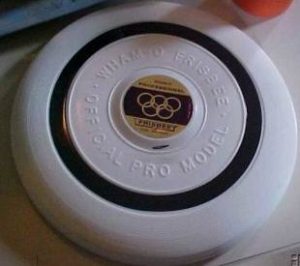 Dan Roddick and Flash Kingsley created a big overall event of national scope called the “Octad.” “Eastern Trick Catch” was one of the eight contested events in the tournament. Eastern trick catch was a game Dan had invented back in the 60’s; points were awarded for trick catches as two players exchanged throws as opponents.
Dan Roddick and Flash Kingsley created a big overall event of national scope called the “Octad.” “Eastern Trick Catch” was one of the eight contested events in the tournament. Eastern trick catch was a game Dan had invented back in the 60’s; points were awarded for trick catches as two players exchanged throws as opponents.
Ken Westerfield and Jim Kenner included a new event at the third annual Canadian Open Frisbee Championships. The event was called “Freestyle” as promoted on the poster for the tournament, and was also called “Free Form” as noted on the trophies that were awarded. This event happened on August 18, 1974, and marked the first ever judged competitive freestyle competition to be held anywhere. The Super Pro had been introduced in test markets, but hadn’t reached the general market yet, so the discs being used were the venerable Wham-O Pro model and the CPI All Star.
There is absolutely no question that the freestyle for pairs event at the 1974 Canadian Open represents the origin of freestyle competition as we know it today. It had it all; the current state of the art players in the game; pairs playing to music for a timed routine; and controversy over the best way to judge. The basic format put together by Jim Kenner and Ken Westerfield on that day well over 42 years ago, is still being used today.
There were only eight teams at this inaugural freestyle for pair’s event. Sixth place went to Irv Kalb and Dave “Buddha” Meyers. Irv put on an awesome display of multiple tipping disc control coupled with the smoothest flowing trick throws the planet had yet seen. Buddha introduced the infamous under-the-shirt catch that was destined to become a trademark for the future Dave Johnson-Chuck Schultz type of the “we’re going to have fun even though we can’t freestyle” routines that were an integral part of the early freestyle scene.
Fifth place went to Doug Corea and Jim Palmeri, (Corea’s future partner Dave Marini hadn’t learned anything fancy yet). Because Jim could manage a catch or two behind the back or between the legs, Doug settled for him as his partner. They placed fifth on the strength of Doug’s huge leaping catches and smooth flowing re-throws.
John Kirkland teamed up with Jose Montalvo to bring home 4th place. John’s dynamic style of play and Jose’s use of a device called the “Molina Stick” foreshadowed things to come in freestyle. Incidentally, it should have been called the “Montalvo Stick,” but it was erroneously named “Molina Stick” in a Flying Disc World article, and the mangled name stuck.
Third place went to Tom Cleworth and John Connelly of the Highland Avenue Aces guts powerhouse. They showed the disc world that the game of guts was not their only disc talent. Tom and John displayed mastery of multiple tipping and trick throwing that was indeed Irv Kalbian in nature.
Dan “Stork” Roddick teamed up with Chicagoan Bruce Koger. Their routine introduced and set the stage for co-op moves. They did a fabulous job of working together and settled for second only because the pair ahead of them also did an incredible job. Somebody had to be second.
Jim Kenner and Ken Westerfield were absolutely awesome. They set the early standard for flow, presentation, continuity, and execution with a variety of fast throws, leaping kick-ups and trick catching. Their transitions from catch to flowing re-throw were silky smooth. As good as the second and third place routines turned out, Kenner and Westerfield left no doubt as to who had the overall winning routine. The primordial first ever judging system wasn’t overly stressed because the good, better and best of the top three routines were obvious enough for the simple ranking system that was used that day. Westerfield and Kenner were sandbaggers though. They were no neophytes that had gotten their taste of freestyle moves just two weeks earlier like most of other players in this event. They had been doing shows and freestyle type demos for several years together, and they clearly demonstrated their experience and expertise.
The competitive freestyle art form, which began its gestation at Berkeley, Michigan, and in Toronto, was born at the Canadian Open on Sunday, August 18, 1974, at approximately 3:00 PM Eastern Daylight Savings Time.
Thanks to the Freestyle Players Association (FPA) for sharing this information with FrisbeeGuru.com.
The entire document is stored on FreestyleDisc.org, as is the FPA’s Hall of Fame.



Pingback: History: 1968-1973; The Formative Years - FrisbeeGuru
Pingback: History: Appendix 1: The Development of Freestyle in Canada - FrisbeeGuru
Pingback: History: Appendix 2: The Tipping Story - FrisbeeGuru
Pingback: Episode 53: John Kirkland and The List - FrisbeeGuru
Pingback: Episode 54: Dan Roddick is Back - The Doctor Operates and the Stork Delivers - FrisbeeGuru